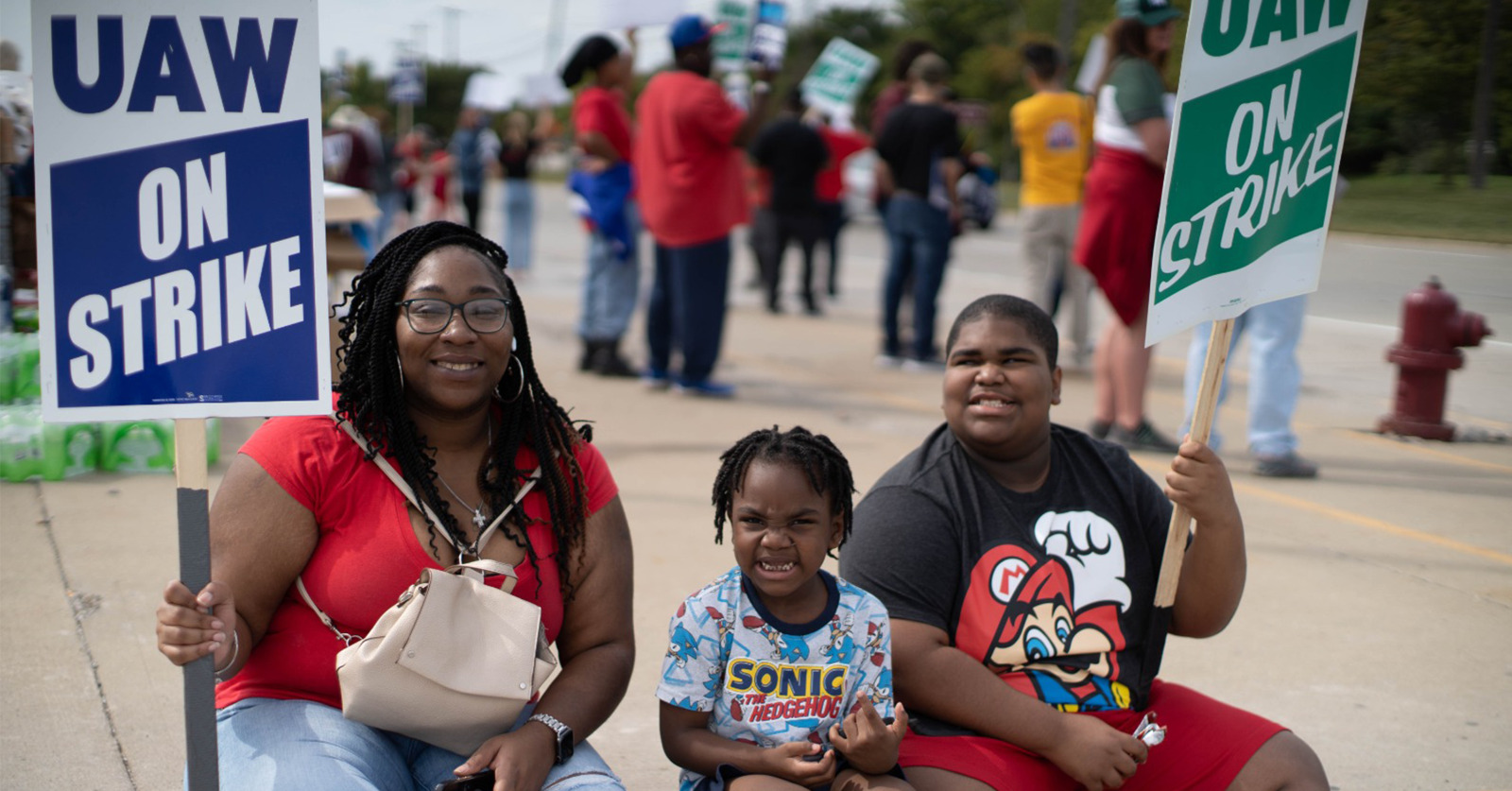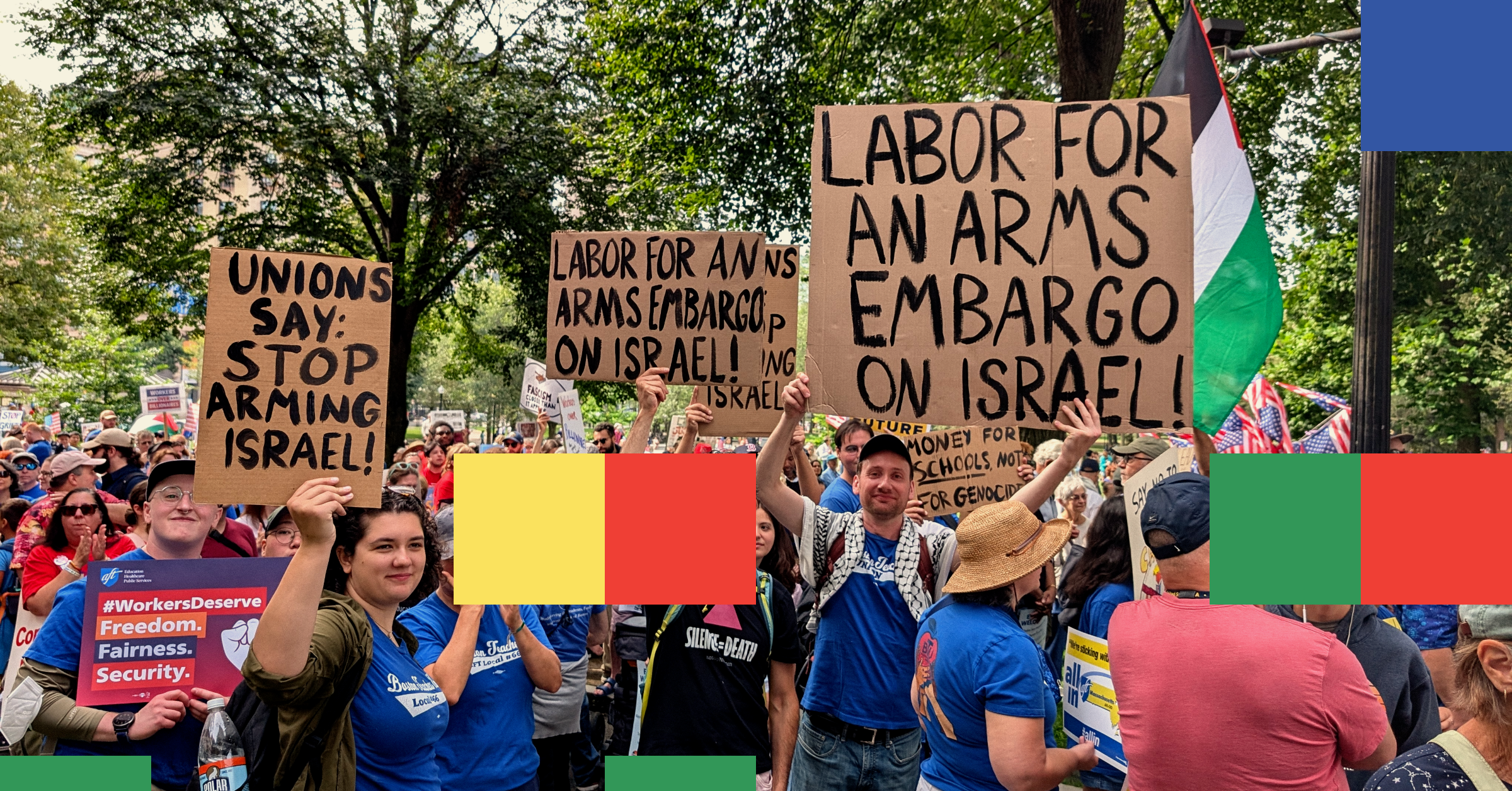On the 41st day of the Auto Workers’ Stand Up Strike, President Shawn Fain announced a deal with Ford. Throughout, the union’s strategy had been to play the Big 3 automakers against each other. The strike began September 15 with just one plant at each company called out. The union escalated weekly, with negotiators rewarding a company that had made concessions to the union by sparing it more strikes, and punishing those tardy to the table.
The straw broke the camel’s back this week when the union hit GM’s and Stellantis’s two biggest money-makers, SUV and truck assembly plants in Texas and Michigan, on Monday and Tuesday. Workers at Ford’s top cash cow, Kentucky Truck, had gone out October 11, and Ford caved on Wednesday rather than see the next domino fall, its F-150 plant in Dearborn, Michigan, which builds the country’s largest-selling truck.
Fain announced that the Ford plants still on strike would return to work pending a membership vote, while GM and Stellantis strikers would remain out. The idea was to let Ford return to making profits while its rivals continued to bleed.
Full details of the tentative agreement will emerge Sunday, when the member ratification process kicks off. It contains big wins while not winning all the union’s demands. Fain announced a 25 percent wage increase over the contract’s four-and-a-half years (11 percent immediately), plus a cost-of-living allowance, profit-sharing, and a ratification bonus. The deal would raise a permanent employee’s starting wage by 68 percent, to more than $28 an hour. Current temporary workers will immediately become permanent.
A Deep Hole to Dig Out
The union’s demands looked impressively ambitious. They included 32 hours work for 40 hours pay – an educational demand no auto worker thought was going to happen – and putting the companies’ new electric vehicle (EV) plants under the master agreements – essential to the union’s future. Fain’s opening salvo called for a 40 percent wage increase, to match CEOs’ own salary hikes, and an end to the pernicious two-tier wage system.
Yet as large as the union’s monetary demands were, they were actually only playing catch-up.
Over and over on the picket lines, auto workers said, “We’re just trying to get back what we gave up.” They needed to reverse the huge concessions given up to the Big 3 automakers since 2007 by earlier United Auto Workers leaders from the once-dominant Administration Caucus. It was a very deep hole to dig out of.
A quick, non-exhaustive list of the concessions:
- Cutting new-hire pay in half
- No raises for existing “legacy” workers for 10 years
- Eliminating cost-of-living allowance (COLA), which adjusted wages for inflation
- No pensions or retiree health care for those hired since 2007
- An eight-year progression to full pay (it had been three years since 1993, with new workers hiring in at 70% of full pay)
- Cutting break time by 17%
- Proliferation of “temps” — low-paid company employees on call whose work week can vary from zero hours to huge amounts of overtime. Temps may remain temps for years.
The new UAW leaders campaigned for office on the slogan “No Tiers, No Concessions, No Corruption.” Fain is often seen in a red “End Tiers” T-shirt. The demand to get rid of tiers — ”everybody equal” — and the noxious effects of people working side by side on vastly different pay scales, is what you hear most often from workers on the line.
The new UPS contract this summer was rightly praised for ending that company’s two-tier system for drivers. Drivers hired since the 2018 contract was negotiated by former president James Hoffa could rise only to $6 less than top pay, and the new contract wipes out that lower tier entirely.
Big 3 auto workers are in a much deeper hole, however. UPS’s second-tier drivers had lower pay but full pensions and health care. To make auto workers whole, they’d need defined-benefit pensions and company-paid health care to tide them over till Medicare (auto work is notoriously hard on the body, with multiple joint surgeries not uncommon). Both those items are super-expensive and were dismissed out of hand by the companies. They offered to improve pensions for those who already have them but only to increase the 401(k) contribution for the second-tier workers shut out of pensions.
Gains
Whatever the shape of the tentative agreement at Ford, the “Stand Up Strike” has won a lot, as Fain has reported weekly to members via Facebook Live. As of October 20 at least one of the Big 3 had agreed to:
- Bring battery and electrical vehicle plants under the master agreement
- Return the wage progression to three years
- Make existing temps permanent (but with the option to hire more)
- Reinstate COLA
- Raise wages by 25%, over a contract of nearly five years
- Raise temps’ starting pay to $21 an hour, from $16-$17
- Eliminate a lower-paid tier for non-assembly plants, raising them to full pay
- Two weeks of paid parental leave
- Right to strike over plant closures
- Increase company’s contribution to 401(k)s to 9.5% plus $1.25/hour
- Increase pensions by $3/month times years of service for future retirees (those hired before 2007 and still on the job)
These gains were won because members struck for them and because of the determination and the strategy of the newly elected leaders – which members have enthusiastically taken up. They love the communication; in the old UAW members would hear nothing about the progress of bargaining till a contract was placed before them. They love how Fain calls out the billionaires and extols the working class (he never calls his members “middle class”). They love the strategy of slowly increasing the automakers’ pain, as new plants are called to strike, unpredictably.
Accustomed to seeing “the union” as something separate (and unloved, though residual loyalty remained), it’s a huge switch for auto workers to feel pride in themselves as union members once again. In more than 40 years of covering the UAW for Labor Notes, I have never seen the spirit on the picket lines that workers are showing this fall. Workers tell me, “This used to be a prestigious job. It used to be a career, but now there’s no incentive for people to stay.” They see this strike as changing that. They were proud to answer Fain’s call.
Challenges Remain
Fain’s challenge was and remains four-fold:
He needed to win a contract that materially changes members’ conditions. A worker with three years’ seniority at Ford explained to me that he’s currently less than half way to full pay, under the existing eight-year progression. When he comes back to work after the strike, he’ll immediately jump to full pay of around $32 an hour — plus the 11 percent pay increase. That’s life-changing. The remaining goal is to win a decent retirement for that worker as well.
Members need to understand how their own actions led to the strike’s outcome. This will be more challenging for the majority who did not strike themselves, so far about two-thirds of the 145,000 at the Big 3. Nonetheless, anyone who attended a practice picket or turned down overtime can feel part of the victory. And members are already proud of the union’s strategy, its transparency, and its militancy.
Members will need to turn newborn pride in their union into member activism in the slower times between contracts. It will take an enormous turn-around to convert leaders’ relationship to members from “sit down and shut up” to “we want everyone on board,” and decades of noxious past practice stand in the way.
The union will need to turn immediately to organizing the non-union auto plants, mostly in the South, owned by Toyota, Mercedes, Volkswagen, Hyundai, Subaru, BMW and others, plus the joint venture EV plants already up and running or soon to come on line.
What Can We Learn From the Reformers’ Victory and the Stand up Strike Thus Far?
You don’t start with a supermajority; you build it through action.
Fain came into office by the skin of his teeth, winning by only about 500 votes out of about 140,000 cast. And that figure is only 14% of the 400,000 active members and 600,000 retirees eligible to vote. The new leaders had a long legacy of cynicism and despair to overcome. Although Fain was installed in office only in late March this year (after a lengthy runoff), thus finally creating a reform majority on the International Executive Board, he and his allies immediately set about proving the union had changed.
Almost all Big 3 local union leaders had backed Fain’s opponent and had come up in the Administration Caucus system where local office was seen as a step toward a cushy job on the staff of the union’s regions (run like fiefdoms) or the International. Fighting the company was discouraged.
Fain’s team, including organizers newly hired for the purpose, introduced the concept of a “contract campaign,” unheard of in the UAW. Members at the Big 3 had never before been asked to pressure the company prior to contract expiration, and striking was unusual. They encouraged Red Shirt Wednesdays and despite opposition from holdovers on the executive board, they set about teaching locals how to hold “practice pickets,” warning management they were ready to strike.
Seize the time of favorable circumstances.
In the notoriously cyclical auto industry, all three of the union automakers are extremely profitable right now. GM just reported third-quarter earnings of $3.5 billion. The Big 3 made a combined $21 billion in the first half of the year. Over the last ten years the three combined made a quarter of a trillion. Fain repeatedly says, “Record profits mean record contracts.” All the companies are figuring out how to transition to an electric future, and seeking huge government subsidies to do so. This year may be a once-in-a-generation opportunity and the union is seizing it.
Organize from below.
Unite All Workers for Democracy (UAWD), Fain’s caucus, was key, encouraging rank-and-filers where local leaders were reluctant, which at first was nearly everywhere. UAWD experienced a surge of interest and continued to recruit raw rank-and-filers to distribute leaflets and hold “10-minute meetings” at break time to spread information and rally the troops. Both the International and UAWD warned members in non-struck plants not to let management change any conditions of employment (which is illegal when the contract expires) and they encouraged members to organize to refuse voluntary overtime.
By the time the strike was a couple of weeks old, Fain himself had rock-star status among the members and a supermajority of Big 3 members was enthusiastically on board. This is not to say that no auto workers feared the economic hardships of striking; no doubt many hoped it wouldn’t be their plant that was chosen to strike. But all were won to the need to strike if they were to win back their losses–and proud to be UAW members, sometimes for the first time in their lives.
While this contract’s gains are real, equally important is the potential to change the character of the union, to make it one with more activists, more committed to fighting the boss in between contracts, more committed to Fain’s dictum that “this is a fight for the whole working class.”




